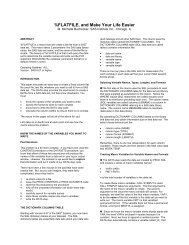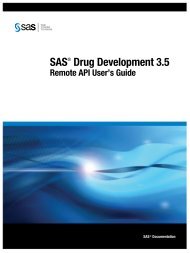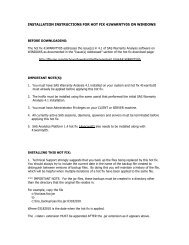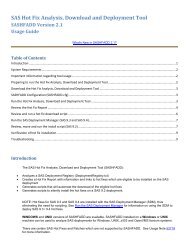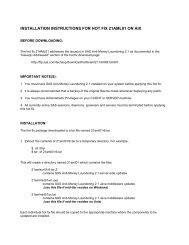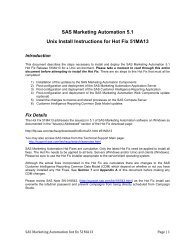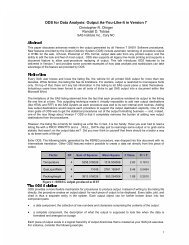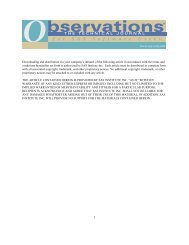SAS 9.3 Web Applications: Clustering - Index of - SAS
SAS 9.3 Web Applications: Clustering - Index of - SAS
SAS 9.3 Web Applications: Clustering - Index of - SAS
You also want an ePaper? Increase the reach of your titles
YUMPU automatically turns print PDFs into web optimized ePapers that Google loves.
n For JBoss, edit the WEB-INF/jboss-web.xml file, and change the contextroot<br />
element as shown in the following example:<br />
<br />
<br />
jms/AlertQueue<br />
javax.jms.Queue<br />
sas/jms/AlertQueue<br />
<br />
<br />
jms/QueueConnectionFactory<br />
javax.jms.QueueConnectionFactory<br />
sas/jms/QueueConnectionFactory<br />
<br />
/<strong>SAS</strong>BIDashboardEventGen<br />
<br />
n For <strong>Web</strong>Sphere Application Server, the context root is set when the WAR file<br />
is deployed.<br />
8 Repackage the sas.eventsgenerationframework.war file from the temporary<br />
directory:<br />
jar cf ../sas.eventsgenerationframework.war .<br />
9 Stop, undeploy, and remove the existing sas.bidashboard4.3.ear file on the <strong>Web</strong><br />
application server.<br />
10 Deploy the repackaged sas.bidashboard4.3.ear and<br />
sas.eventsgenerationframework.war applications.<br />
For deployments that use <strong>Web</strong>Sphere Application Server, make sure that when the<br />
<strong>SAS</strong> <strong>Web</strong> applications are reinstalled, that the class loader order is set to Classes<br />
loaded with the application class loader first for each <strong>Web</strong> module. If the class<br />
loading order is incorrect, then <strong>SAS</strong> BI Dashboard can generate HTTP 500 errors<br />
when trying to access the com.sas.collection.StaticDictionaryInterface class.<br />
Reconfigure the <strong>SAS</strong> Content Server<br />
Repository<br />
Reconfigure the <strong>SAS</strong> Content Server Repository 7<br />
The <strong>SAS</strong> Content Server <strong>Web</strong> application can be configured by the <strong>SAS</strong> Deployment<br />
Wizard to use a file system or a database for storing content. The index for the<br />
repository is stored on a file system even if content is stored in a database. To<br />
deploy multiple instances <strong>of</strong> <strong>SAS</strong> Content Server, it must be configured to use a<br />
database for storing content, and it must also be configured so that indexes are<br />
stored in unique directory names.<br />
The following steps describe how to determine whether <strong>SAS</strong> Content Server is using<br />
file system for storage and how to reconfigure it to use unique directory names for<br />
indexes.<br />
1 Determine whether the file system or a database is used for storage. Open the<br />
<strong>SAS</strong>-config-dir/Levn/AppData/<strong>SAS</strong>ContentServer/Repository/<br />
repository.xml file and check the class attribute for the FileSystem element.





